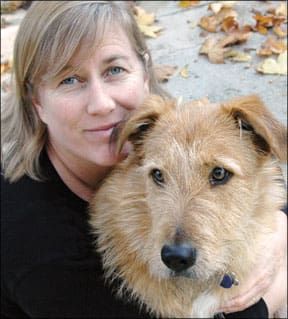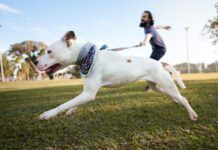When I visited my brother and his very pregnant wife last month, to take pictures for ”Family Planning,” our August article about getting dogs ready to live with children, I noticed that their dog, Hannah, was quite a bit fatter than I had last seen her. I was surprised; Keith told me that he had been spending much more time walking Hannah than in previous months. The goal was to tire her out (a tired dog is a good dog) and to work on her training before the baby arrived.
Playing pet detective, I asked Keith if he had been giving her many treats on their walks. ”Of course!” he replied indignantly. ”We read Whole Dog Journal!”
”What sort of treats are you are giving her?” I asked – and the mystery was instantly solved. The treats were biscuit-style cookies, each about the size of an Oreo. A handful of these each day would certainly add up to quite a few extra calories for Hannah, even considering the extra exercise she was getting. Keith said he had been breaking the cookies so he could feed Hannah a greater number of small pieces, but I noticed that the biscuits were so hard, they were difficult to break into more than two or three segments.
I praised Keith for using positive reinforcement and classical conditioning on his walks with Hannah. But I also suggested that he use much smaller treats, and that he alternate between bits of biscuits and tiny high-value treats like pieces of chicken or cheese. My trainer friend Sandi Thompson describes the ideal training treat as a tiny burst of flavor in the dog’s mouth.
Keith admitted that he liked using biscuits as treats because they didn’t get his pockets all gooey. Aha! I had a perfect gift for him in the car: my bait bag, a fully lined nylon pouch that straps around the waist and can hold greasy, yummy treats and a plastic bag or two, too. Of course, I had to go buy another bait bag for myself; I don’t take my dog, Otto, anywhere without a mix of kibble and high-value treats to use for training and counter-conditioning.
My advice to Keith and Leslie was off the cuff; I had’nt yet read Whole Dog Journal contributor Mary Strauss’s article on how to help a dog lose weight. Since he’s a regular Whole Dog Journal reader, I’m sure he’ll get far more information and advice from the article (which appears in this issue) than he did from me.
In spite of all this buildup, I havent heard any reports about Hannah’s current weight, because mostly what I’ve been talking to Keith and Leslie about is their newborn baby daughter! And, of course, how Hannah is coping with the loss of her only child status. I was proud when Keith reported that, as our August article had suggested, he had been bringing baby Ava’s blankets and clothing home so Hannah could smell them, days before Ava herself came home from the hospital. And I was absolutely thrilled when he told me that all the training he and Leslie had been doing was really paying off; Hannah was calmly going to her spot when asked to do so.
Best yet, while she initially acted concerned and curious when Ava cried, Hannah was easily distracted by the treats that the new parents liberally dropped for her as they attended to the crying baby. It’s a winning tactic for counter-conditioning a dog who is anxious about a baby. Whole Dog Journal contributor Lisa Rodier recently sent me a note about her friend Samantha Fogg, a positive trainer from Georgia, who had a baby in March.
Samantha just started teaching classes again, with her baby, Emma, strapped to her chest. Her students have been instructed that any time the baby shrieks or cries, to feed their dogs. She told me last night that the dogs are now starting to look at their owners as soon as Emma makes a noise. How cool is that? Very, very cool.






